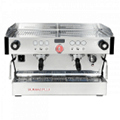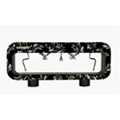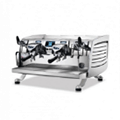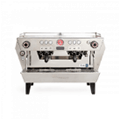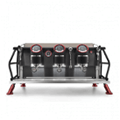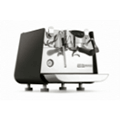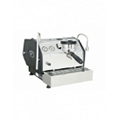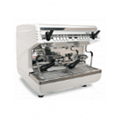For most coffee shop owners, the espresso machine is by far the biggest investment they’ll make. With tens or even hundreds of thousands of riyals at stake, choosing the right machine can be a nerve-wracking process. While we can’t make that decision for you, this guide should take some of the stress out of it by helping you narrow down your options. Once you know what you’re looking for, finding ‘The One’ can be an amazing feeling.
The first — and most reassuring — thing you should know is that it’s possible to make great espresso from nearly any commercial machine. Even if your budget is tight, there’s no reason you can’t serve your customers the very best coffee — as long as you’re willing to put in the work.
Spending more money should achieve two things:
- make it easier to keep quality consistently high when you’re busy;
- allow you to serve more customers at a time.
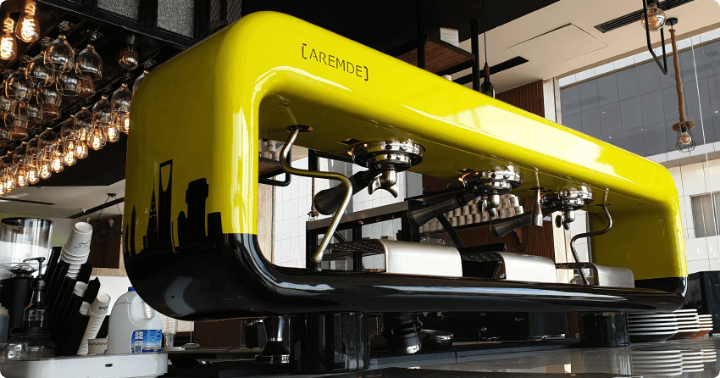 Aremde coffee machine at Kim’s Coffee, Riyadh
Aremde coffee machine at Kim’s Coffee, Riyadh
What do you need to make great coffee?
An espresso machine seems complicated, but actually has a pretty simple job: it pushes hot water through a bed of coffee. It controls the temperature, the pressure, and the volume of water — and that’s all you need for great espresso.
- Temperature stability is the first point to check when you’re choosing a machine. Budget machines usually use a single boiler to heat both the steam and the brewing water. In these machines, the temperature usually can’t be adjusted, and might vary by a degree or two from one shot to the next, especially if you’re using the steam wand a lot. Spending a bit more money gets you separate boilers for brewing and steam, which makes the temperature much more stable and easy to control. The best machines can control the brewing temperature to within 0.1 °C, and even allow you to use different temperatures for different coffees.
- For most espresso machines, the brewing pressure is fixed, usually at 9 bars. The best espresso machines allow more control over the pressure during the shot. In its simplest form, a few seconds of low-pressure water at the start of the shot, known as pre-infusion, can make your espressos tastier and more consistent. More complex designs allow you to change the pressure throughout the espresso, opening up a lot more flavor possibilities.
- Finally, the volume of liquid in the cup can be controlled manually, using a shot glass or a set of scales, but a machine that does this for you makes your baristas’ lives much easier and is highly recommended. Most machines on the market today are ‘volumetric’ — they measure the flow of water through the machine, to give you roughly the right volume of espresso in the cup automatically. A ‘gravimetric’ machine such as the Black Eagle Gravitech takes this a step further by weighing the liquid in the cup itself using built-in scales, giving you exactly the right amount of espresso, shot after shot.
So to get the basics right, here are the three things to look for in a perfect machine: separate boilers for brewing and steam; some form of pre-infusion; and high quality volumetric or gravimetric control.
What else should you keep in mind?
Don’t be dazzled by digital displays, bluetooth connections, and touchscreens; instead focus on the features that are going to be useful each time you make a coffee.
Since nearly all machines work in similar ways, they are often sold on their extra features — the bells and whistles that distinguish one machine from the next. But some features have a much bigger impact than others.
Your baristas will thank you for:
- cool touch steam wands, so they don’t burn their hands;
- adjustable drip tray height, so you can fit your tallest cup perfectly under the spouts;
- automated cleaning cycles, or even an automatic flush after each shot.
Don’t neglect the design of the machine, either. The choice of machine says a lot about your cafe, so make sure it fits your aesthetic, whether you go for a classic look like the La Marzocco PB X, or a striking design statement like the Aremde S2GV.
Whatever machine you choose, double check that it has the right dimensions for your bar, and that you have the right power connections. Many machines need three phase electricity, while others can be converted between two and three phase. Nearly all need a dedicated, high power connection.
Lastly, consider your maintenance and aftersales needs: make sure the technicians in your area know how to service your machine, or you are storing up trouble for the future.
How many groups?
The ‘group’ or ‘grouphead’ on the machine is where the coffee is made, so a two group machine allows you to make two double espressos — or four singles — simultaneously.
Two or Three
The most common configuration is two groups, and that is sufficient for most coffee shops. Three groups can be helpful in very busy cafes, where you might need to make more than 50 drinks per hour during busy periods. Having a third group can also be useful if you want to set aside one group for brewing with a different recipe, for example by setting it to a different temperature.
If you plan to sell a lot of coffee, look for two or three group machines with large, separate steam boilers and high-quality volumetric or gravimetric controls. Great examples to consider include:
The One Group Wonder
For small cafes and restaurants, one group is sometimes enough. If you expect to make less than 100 cups of coffee per day, and rarely more than two or three drinks at any one time, then a one group machine might fit the bill and save on space and budget. Buying a second portafilter can help you keep up during busier times, even with only one group head.
Avoid domestic machines that won’t stand up to commercial use. Instead, look for a purpose-built commercial one group machine.
Excellent one-group machines include:
Alternatively, if you want the flexibility of two group heads but need to save on space, consider a compact machine like the Nuova Simonelli Appia II Compact, which packs two groups into a small footprint.
Now that you know what the essential features of any good espresso machine are, finding the right one for you should become a little easier. In the next article, we’ll help you narrow your choice down even further. Read on for our guide to the best espresso machines for every type of business.
Still searching for The One?
Contact our team for a free personalized consultation,
and we will help you find what you’re looking for.


